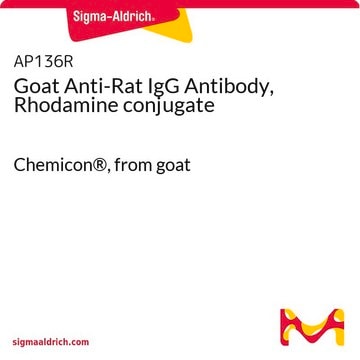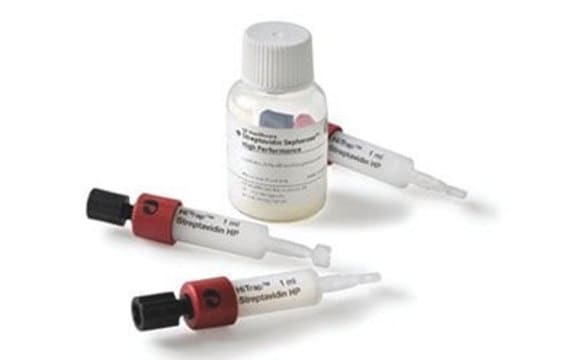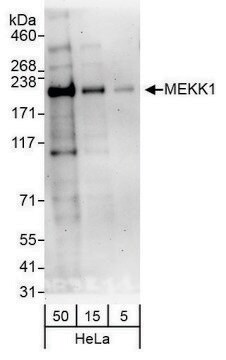AP128R
Goat Anti-Mouse IgM Antibody, µ chain, Rhodamine conjugate
Chemicon®, from goat
Sign Into View Organizational & Contract Pricing
All Photos(1)
About This Item
UNSPSC Code:
12352203
eCl@ss:
32160702
NACRES:
NA.46
Recommended Products
biological source
goat
Quality Level
conjugate
TRITC conjugate
rhodamine conjugate
antibody form
F(ab′)2 fragment of affinity isolated antibody
antibody product type
secondary antibodies
clone
polyclonal
species reactivity
mouse
manufacturer/tradename
Chemicon®
technique(s)
immunofluorescence: suitable
shipped in
wet ice
target post-translational modification
unmodified
Application
Goat anti-Mouse IgM Antibody, μ chain, Rhodamine conjugate is an antibody against Mouse IgM for use in IF.
Research Category
Secondary & Control Antibodies
Secondary & Control Antibodies
Research Sub Category
Fragment Specific Secondary Antibodies
Fragment Specific Secondary Antibodies
Legal Information
CHEMICON is a registered trademark of Merck KGaA, Darmstadt, Germany
Disclaimer
Unless otherwise stated in our catalog or other company documentation accompanying the product(s), our products are intended for research use only and are not to be used for any other purpose, which includes but is not limited to, unauthorized commercial uses, in vitro diagnostic uses, ex vivo or in vivo therapeutic uses or any type of consumption or application to humans or animals.
Not finding the right product?
Try our Product Selector Tool.
Hazard Statements
Precautionary Statements
Hazard Classifications
Aquatic Chronic 3
Storage Class Code
11 - Combustible Solids
WGK
WGK 3
Certificates of Analysis (COA)
Search for Certificates of Analysis (COA) by entering the products Lot/Batch Number. Lot and Batch Numbers can be found on a product’s label following the words ‘Lot’ or ‘Batch’.
Already Own This Product?
Find documentation for the products that you have recently purchased in the Document Library.
De-Hua Lai et al.
Proceedings of the National Academy of Sciences of the United States of America, 118(8) (2021-02-19)
Centrioles and basal bodies (CBBs) are found in physically linked pairs, and in mammalian cells intercentriole connections (G1-G2 tether and S-M linker) regulate centriole duplication and function. In trypanosomes BBs are not associated with the spindle and function in flagellum/cilia
Caroline Pinet-Charvet et al.
Scientific reports, 10(1), 10654-10654 (2020-07-02)
The control of ovulation helps guarantee the success of reproduction and as such, contributes to the fitness of a species. In mammals, two types of ovulation are observed: induced and spontaneous ovulation. Recent work on camelids, that are induced ovulators
Jeremy A Murphy et al.
Investigative ophthalmology & visual science, 52(10), 7771-7777 (2011-08-30)
To characterize the influence of endothelin-1 (ET-1) on optic nerve head astrocyte (ONHA) proliferation and Ca²⁺ signaling in ONHAs lacking functional endothelin B (ETB) receptors. ONHAs were isolated from adult wild type (WT) and transgenic spotting lethal (TSL) rats, lacking
Brendan Doyle et al.
Stem cells and development, 17(5), 941-951 (2008-06-20)
Administration of endothelial progenitor cells (EPC) is a promising therapy for post-infarction cardiac repair. However, the mechanisms that underlie apparent beneficial effects on myocardial remodeling are unclear. In a porcine model of acute myocardial infarction, we investigated the therapeutic effects
Lukas F Reissig et al.
Histochemistry and cell biology, 159(1), 23-45 (2022-10-07)
Immunohistochemistry is a powerful tool for studying neuronal tissue from humans at the molecular level. Obtaining fresh neuronal tissue from human organ donors is difficult and sometimes impossible. In anatomical body donations, neuronal tissue is dedicated to research purposes and
Our team of scientists has experience in all areas of research including Life Science, Material Science, Chemical Synthesis, Chromatography, Analytical and many others.
Contact Technical Service








